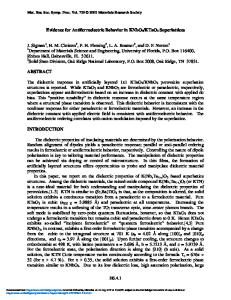Superlattices of PbTiO 3 /SrTiO 3 Exhibit Improper Ferroelectricity
- PDF / 90,256 Bytes
- 1 Pages / 576 x 783 pts Page_size
- 33 Downloads / 384 Views
Crystal Structure for Approximate Optical Invisibility Cloaking Proposed Electromagnetic cloaking of materials has long been fantasized in science fiction tales, but has recently been shown to be theoretically possible. Experimentally, limited forms of cloaking have been realized in the microwave region of the spectrum. Significant work is underway to investigate approaches to cloaking in the optical region of the spectrum. D. Xiao and H. Johnson, of the University of Illinois at Urbana-Champaign, propose a photonic crystal structure capable of approximate cloaking in the optical regime. Their calculations, reported in the April 15 issue of Optics Letters (p. 860), show that anisotropy in an axisymmetric silicon photonic crystal can serve as a waveguide to bend light around an object. Xiao and Johnson develop a cloaking schema based upon a perfectly layered silicon and air structure that provides approximate cloaking in the optical regime. As opposed to an ideal cloak, a refractive index matched material, this approximate scheme uses a multiply layered structure to
Superlattices of PbTiO3/SrTiO3 Exhibit Improper Ferroelectricity
a PML
y (ȝm) 5
air
Inner part (8 Si layers) Outer part (5 Si layers)
d1
0
air
Source line
Monitor line
PML
-5 8
0
-5
x (ȝm)
b
Field distribution
4.5
Transmitted power Output Reference
H 9
0
-4.5 -4.5
0
guide the light around an obstacle and prevent it from entering the object, as illustrated in Figure 1. The photonic band structure of the proposed axisymmetric crystal structure in silicon results in a tangential index of refraction of 1.13 and a radial index of 2.07, resulting in double action as both waveguide and waveblock. In order to establish a baseline for the efficacy of the cloak, the researchers conducted numerical experiments to compare the optical properties of the proposed cloak with those of an ideal cloak, both illuminated with a Gaussian beam of light. They used these simulations to predict the sensitivity of the cloak to the ratio of particle size to wavelength. Their analysis indicates that the index matched cloaking functions well when the object size is less than 0.05% of the wavelength of the incident light, but that these cloaks are very sensitive to material perturbations and fail as object size-to-wavelength ratio in creases. Though the cloak proposed here is approximate, these results show a potential way to engineer a cloaking device on a larger scale, said the researchers. ARTHUR FELDMAN
7.5
2E-5 4E-5 6E-5
Figure 1. (a) Illustration of the axisymmetric silicon cloaking device. (b) Demonstration of the magnetic field and power distribution of the device in response to a Gaussian beam. The red lines illustrate the output with the cloaking device and the black is the reference system without the object. Reprinted with permission from Optics Letters 33 (8) (April 15, 2008) p. 860. ©2008 Optical Society of America.
As materials researchers gain increasingly fine control over epitaxial thin film growth, they often find that unexpected properti
Data Loading...











